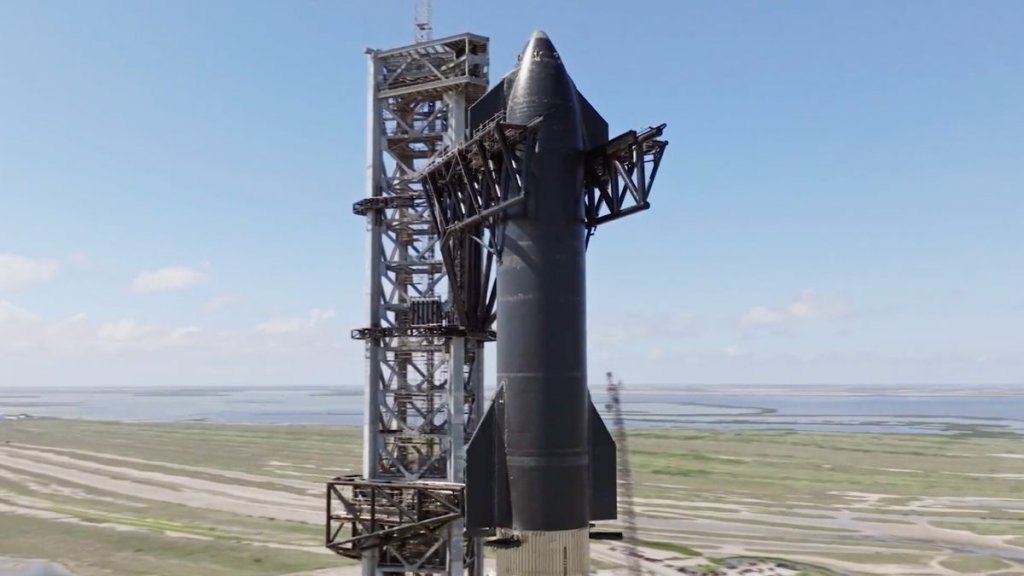Update for Nov. 18: SpaceX says all systems and weather are GO for its second Starship launch test today at 8 a.m. EST (1300 GMT). You can watch it live here beginning at 7:30 a.m. EDT (1230 GMT).
This weekend is shaping up to be an exciting day for space fans.
SpaceX plans to launch the second-ever test flight of its giant Starship rocket on Friday from Starbase, the company’s facility in far southern Texas. Liftoff is scheduled to occur on Saturday (Nov. 18) during a 20-minute window that opens at 8 a.m. EST (1300 GMT), and you can watch all the action here at Space.com.
But just what will that action entail? Read on for a short explainer of this highly anticipated mission.
Related: Watching SpaceX launch Starship, the world’s largest rocket, was simply unreal (video)
Starship Die Cast Rocket Model Now $69.99 on Amazon.
If you can’t see SpaceX’s Starship in person, you can score a model of your own. Standing at 13.77 inches (35 cm), this is a 1:375 ratio of SpaceX’s Starship as a desktop rocket model. The materials here are alloy steel and it weighs just 225g.
Note: Stock is low so you’ll have to act quickly to get this.
” data-widget-price=”{“currency”:”USD”,”amount”:”69.99″}” data-widget-type=”deal” data-render-type=”editorial”>
The show will begin at 7:30 a.m. EST (1230 GMT), the time SpaceX plans to start its launch webcast. About 10 minutes later, Starship’s 39 Raptor engines — 33 on the Super Heavy first stage and six on the upper-stage spacecraft, known as Starship — will begin to chill ahead of ignition, according to SpaceX’s mission description.
Ten seconds before launch, SpaceX will activate the water deluge system beneath Starbase’s orbital launch mount. This piece of equipment — a reinforced, water-spraying steel plate — is designed to dampen the power of Super Heavy’s 33 Raptors, protecting the launch mount and surrounding infrastructure.
That power was on full display during Starship’s first (and so far only) test flight, which occurred on April 20. Super Heavy’s Raptors blasted out a crater beneath the launch mount that day, sending chunks of concrete and other debris flying high into the South Texas sky.
The April 20 flight aimed to send the upper stage partway around Earth, with a splashdown targeted in the Pacific Ocean near Hawaii. That didn’t happen, however; Starship’s two stages failed to separate, and SpaceX detonated the vehicle intentionally four minutes after liftoff.
Related: Incredible photos of SpaceX’s 1st Starship launch
Saturday’s flight has the same basic goals as the April 20 jaunt.
If all goes according to plan, Starship’s two stages will separate two minutes and 41 seconds after liftoff. This will be accomplished via “hot staging,” in which the upper stage engines begin firing shortly before separation. That’s a change from the first launch, which employed a traditional staging strategy.
Super Heavy will perform several engine burns over the next few minutes, steering itself toward a splashdown in the Gulf of Mexico around seven minutes after liftoff.
The Starship upper stage, meanwhile, will continue powering its way upward and eastward, reaching a top speed close to orbital velocity (which is around 17,000 mph, or 27,400 kph). But the vehicle won’t complete a circuit of Earth; roughly 90 minutes after liftoff, it will come down in the Pacific near Hawaii for “an exciting landing,” SpaceX’s mission description states.
Both Starship stages are designed to be fully and rapidly reusable, but Friday’s flight will be the only mission for these particular pieces of hardware. SpaceX’s mission description shows both stages coming down directly into the sea, not on a drone ship, as the first stages of the company’s Falcon 9 and Falcon Heavy rockets commonly do.
Whatever happens on Friday — complete success, total failure or (most likely) something in between — expect another Starship launch in the not-too-distant future. SpaceX is working on multiple Starship vehicles at the moment, and it plans to learn from the flights of all of them.
“This rapid iterative development approach has been the basis for all of SpaceX’s major innovative advancements, including Falcon, Dragon, and Starlink,” the company’s mission description states. “Recursive improvement is essential as we work to build a fully reusable transportation system capable of carrying both crew and cargo to Earth orbit, help humanity return to the moon, and ultimately travel to Mars and beyond.”
Editor’s note: This story was updated at 2:45 pm ET to include the new launch date for SpaceX’s Starship Second Test Flight due to a 24-hour delay.

